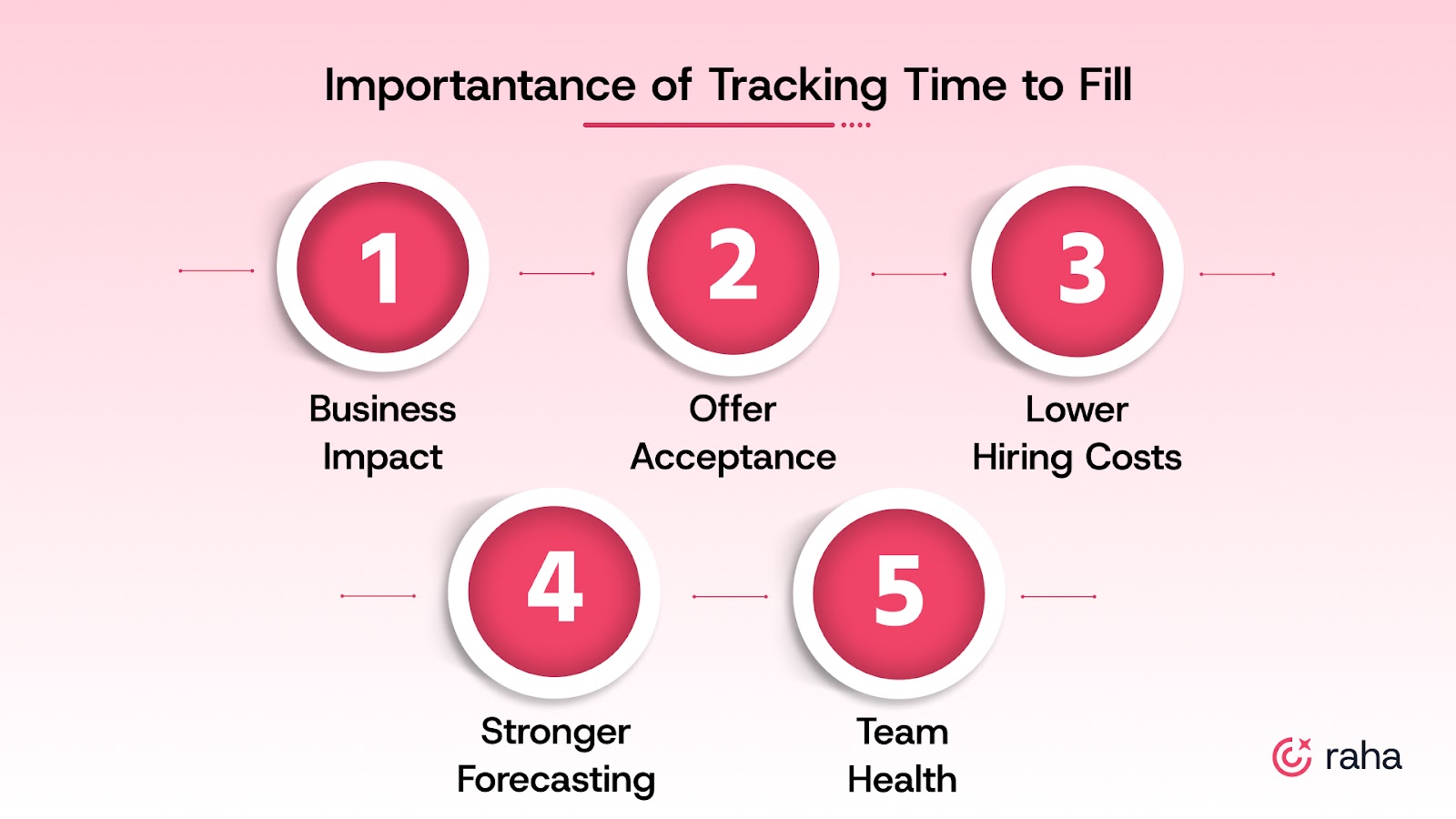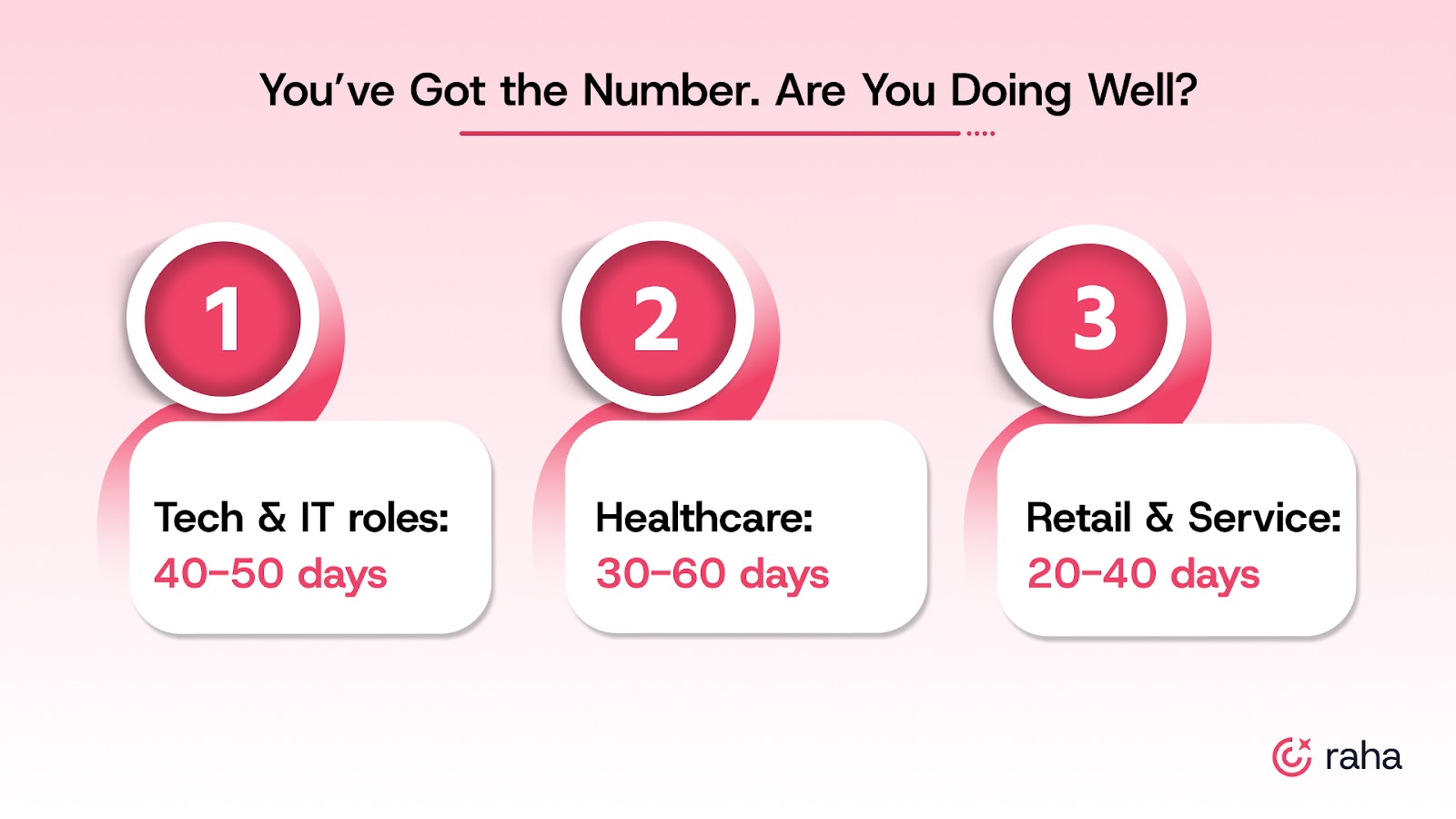
Time to Fill doesn’t get flagged until something’s already broken. Until your sales team’s short by two heads, or your product roadmap slips because engineering is running lean.
The average time to fill a role in the U.S. is now 44 days. That’s a month and a half where your business is underpowered. A month and a half where the best candidates are off the market, and your funnel is full of second-choice options.
And if you’re filling high-skill roles, it’s often longer. Which means: your hiring motion is leaking opportunity.
The goal isn’t just to move faster. The goal is to understand why it’s slow and identify which parts of your process are contributing to that delay. Because Time to Fill is rarely about sourcing, it’s about friction, misalignment, over-engineered approvals, unclear scope, and indecisive loops.
In this blog, we’ll break down exactly what Time to Fill reveals, where to focus, and how to shift it from a lagging indicator into a lever you can pull before it impacts business outcomes.
What is Time to Fill?
At the surface level, Time to Fill is simple: it’s the number of calendar days between when a role is opened and when a candidate accepts the offer. But for teams that operate at scale, it’s more than a metric—it’s an early warning system.
When tracked properly, Time to Fill surfaces deep operational truths:
- How clean is your intake process?
- How fast do your hiring managers move?
- How realistic is your comp and role definition?
- Where are your internal bottlenecks—approval chains, interview loops, negotiation cycles?
It’s a mirror, not just of recruiting performance, but of org alignment.
An experienced team will understand that if a role is sitting open for 45+ days, the problem didn’t start in sourcing. It started upstream when the role was poorly scoped, the intake was vague, or the hiring managers weren’t aligned.
The goal isn’t to hit an arbitrary number. It’s to understand what’s driving the number, and fix the parts of your system that are dragging speed, burning recruiters, or bleeding candidates.
At this point, many teams confuse Time to Fill with Time to Hire. They’re often used interchangeably, but they’re not the same.
Time to Fill vs. Time to Hire
Time to Fill and Time to Hire are often confused, but they expose different problems. If you don’t separate them, you won’t know whether your issues are coming from pipeline generation or internal execution.
Let's break down the distinctions:
- Time to Fill starts when a job requisition is approved and ends when the offer is accepted. It includes internal steps like approvals, alignment, job posting, and sourcing.
- Time to Hire starts when a candidate enters the funnel. It ends when they accept the offer. This metric focuses only on candidate movement, not internal delays.
Tracking both metrics helps identify process challenges. A high time to fill, combined with a low time to hire, suggests that while your recruitment team is efficient in closing candidates, there may be delays in earlier stages, such as job requisition or posting.
Why Tracking Time to Fill is Important?

Time to Fill is more than a metric. It directly impacts hiring speed, cost, and the quality of candidates. Tracking this metric gives you control over outcomes that matter:
- Faster business impact: Roles get filled sooner, teams stay productive, and plans stay on track.
- Higher offer acceptance: Candidates are more likely to accept your offer when your process moves quickly.
- Lower hiring costs: Fewer delays mean lower ad spend, recruiter time, and lost output.
- Stronger forecasting: You can plan headcount with fewer surprises and last-minute escalations.
- Better team health: Shorter vacancies reduce overload and burnout for existing team members.
Let’s break down how to calculate Time to Fill and how to turn it into something you can act on, not just report.
How to Calculate Time to Fill?
The calculation is simple. The impact lies in how you use it.
Formula:
Time to Fill = Offer Accepted Date – Requisition Opened Date
For example, if a role opens on January 8 and the candidate accepts the offer on January 31, your Time to Fill is 23 days.
Now, that’s just a number. To get real value from this metric, segment it. Track it by department, role type, or seniority level. That’s where patterns emerge, such as engineering taking longer than sales, or leadership roles dragging on in the interview process.
You can also break it down by stage:
- How long from requisition to first sourced candidate?
- How long from the final interview to offer approval?
This lets you pinpoint delays and fix the right part of the process, rather than guessing.
You’ve Got the Number. How Do You Know If You’re Doing Well?

Once you’ve calculated your Time to Fill, the next step is context. Is 30 days good? Is 45 a red flag? You won’t know unless you benchmark.
Industry standards give you a baseline to compare against and highlight where your hiring engine might be lagging.
Here’s how Time to Fill typically looks across sectors:
- Tech and IT roles: 40-50 days. Demand is high, and top talent moves fast.
- Healthcare: 30-60 days. Specialized roles and credentialing add complexity.
- Retail and Customer Service: 20-40 days. High-volume roles tend to move more quickly, often due to urgency.
Similarly, Time to Fill will vary by role complexity, seniority, and market maturity. Entry-level or high-volume roles often progress more quickly. Executive or niche positions naturally take longer due to smaller talent pools and longer decision cycles.
Factors such as team structure, employer brand, internal approvals, and location also influence your timelines. That’s why this guide should be used as a directional reference, not a fixed standard.
How to Know Your Time to Fill Is Breaking
You don’t need a dashboard to know when something’s off. It shows up in your day before it shows up in the metrics.
You’re chasing feedback that should’ve landed three days ago.
Your best candidate goes dark after panel round two.
And suddenly, the VP is asking why their role is still open after six weeks.
Sound familiar? Here’s what we look for when Time to Fill quietly starts slipping:
- Inconsistent closure across similar roles
Same level, same market, totally different outcomes. That’s usually intake quality or prioritization, rarely pipeline. - Mid-funnel drag
You’ve got candidates in process, but nothing’s moving. Interviews keep rescheduling, feedback is late, and offers stall. That lag adds up fast. - Close rates dip while req loads stay high
When recruiters are juggling multiple open roles but can’t close, it’s a process problem. They’re stuck doing ops work, not driving decisions. - You’re hearing about delays from hiring managers before your team flags them
By then, it’s reactive. You’re already in clean-up mode instead of fixing the root cause. - One team is always slow, but no one’s owning it
Whether it’s tech, sales, or leadership, patterns like this indicate that something is baked into the process: alignment, approvals, or bandwidth.
Time to Fill doesn’t break overnight. It slips slowly until it becomes visible at the worst time: in front of leadership, or during headcount planning.
Want to Reduce Time to Hire? Automate It.
If recruiters are still scheduling interviews, chasing feedback, and sending reminders by hand, you're wasting time. Not just theirs, but also the candidate’s.
This is what slows down hiring. It’s not a lack of effort. It’s the clutter in the process that no one has time to fix manually.
64% of recruiters say manual processes are slowing them down.
Automation changes that. With a tool like Raha AI, the scheduling, follow-ups, and coordination happen without friction. Candidates move faster. Hiring managers respond on time. Recruiters can focus on actual decision-making rather than administrative tasks.
You want a faster Time to Hire? Remove the manual steps. See how Raha helps teams move faster and close stronger.
Before You Move On
If your Time to Fill is climbing, it’s not just a number problem—it’s an operational one. And it’s costing you candidates.
Track it properly. Benchmark it smartly. But more importantly, look at where it’s slowing down. That’s where the fix lives.
If your team’s buried in coordination and follow-ups, you don’t need more effort. You need better systems.
Raha’s already helping teams cut dead time and close roles faster. If speed and quality both matter, this is where you start.
FAQs
Q1. How does Time to Fill affect the hiring process?
A: A longer time to fill can lead to increased recruitment costs, lost productivity, and a negative candidate experience. However, a quicker time to fill helps you secure top talent faster and reduces the disruption caused by vacant positions.
Q2. Does Time to Fill impact candidate quality?
A: While a quicker Time to Fill is desirable, it's important not to rush the process and compromise on candidate quality. Balancing speed and quality is essential to making the right hire.
Q3. How does Time to Fill impact employer branding?
A: A lengthy hiring process can negatively affect employer branding, as candidates may perceive delays as a sign of disorganisation. A faster, more efficient process enhances your brand's reputation by showing that you value candidates' time and are committed to a positive experience.
Q4. Can external factors influence Time to Fill?
A: Yes, external factors such as market demand for specific skills, industry trends, economic conditions, and competition for talent can all impact time to fill. For example, finding suitable candidates during high employment may take longer.
Q5. How can Time to Fill help with workforce planning?
A: Tracking time to fill over time helps HR teams forecast hiring timelines, identify potential delays, and plan better for workforce needs, ensuring roles are filled quickly without disrupting business operations.

